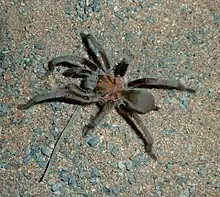Selenocosmia stirlingi
Selenocosmia stirlingi is a species of spider with the common name barking spider. The barking spider is a desert species with special adaptations to survive harsh weather conditions. It is a hairy tarantula and, like all spiders, they have two body segments, eight legs and two palps for sensing and feeling their prey.
| Barking spider | |
|---|---|
 | |
| Scientific classification | |
| Kingdom: | Animalia |
| Phylum: | Arthropoda |
| Subphylum: | Chelicerata |
| Class: | Arachnida |
| Order: | Araneae |
| Infraorder: | Mygalomorphae |
| Family: | Theraphosidae |
| Genus: | Selenocosmia |
| Species: | S. stirlingi |
| Binomial name | |
| Selenocosmia stirlingi Hogg, 1901 | |
Taxonomy and naming
The barking spider gets its name from the low growling it produces by rubbing its palps together. This is done to scare off predators.
Habitat

Barking spiders live in the Australian desert and are ambush predators from burrows placed among leaf litter.
Prey
Barking spiders wait in their burrows for insects, lizards or frogs to come near the entrance before grasping and injecting venom into them.
Predators
As it is a small animal, the barking spider has quite a lot of predators even in the desert. Some of these include owls, dingoes and feral cats.
Adaptations
The barking spider depends on special adaptations to survive in its natural habitat. They have a gill-like lung that requires humidity and strong claws that enables them to dig burrows and stay cool. Barking spiders also have bushy feet with some secreted oil which produces a suction-cup ability, which allows them to easily climb up steep rocks in the desert.